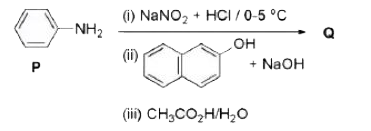Consider the reaction sequence from P to Q shown below . The overall yield of the major product Q from P is 75% . What is the amount in grams Q obtained from 9.3 mL of P ? (Use density of P = 1.00 g mL−1 , Molar of C = 12.0 , H = 1.0 , O = 16.0 and N = 14.0 g m −1

The correct Answer is:18.60

⇒ Mass mass of .P. (C6H7N)=93g
⇒ Mole of .P. = (9.3gml×1ml)×193g=0.1 mole
⇒ Molar mass of .Q.= 248 g
⇒ Mole of . Q . produced = 0.1 mole
Mass of . Q . produced =(0.1×248×0.75)g=18.60g
Topper's Solved these Questions
- BOOK - JEE ADVANCED PREVIOUS YEARCHAPTER - JEE ADVANCED 2020EXERCISE - SECTION-26videos
JEE ADVANCED 2020
- BOOK - JEE ADVANCED PREVIOUS YEARCHAPTER - JEE ADVANCEDEXERCISE - CHEMISTRY SECTION - IV : Matric Match Type2videos
JEE ADVANCED
- BOOK - JEE ADVANCED PREVIOUS YEARCHAPTER - JEE ADVANCED 2021EXERCISE - QUESTION38videos
JEE ADVANCED 2021
Similar Questions
The stoichiometric reaction of 516g of dimethyldichlorosilane with water results in a tetrameric cyclic product X in 75% yield. The weight (in g) of X obtained is___.
[Use, molar mass(gmol−1):H=1,C=12,O=16,Si=28,Cl=35.5]View SolutionA trinitro compound, 1,3,5-tris-(4-nitrophenyl)benzene, on complete reaction with an excess of Sn/HCl gives a major product, which on treatment with an excess of NaNO2/HCl at 0∘C provides P as the product. P, upon treatment with excess of H2O at room temperature, gives the product Q. Bromination of Q in aqueous medium furnishes the product R. The compound P upon treatment with an excess of phenol under basic conditions gives the product S.
The molar mass difference between compounds QandR is 474gmol−1 and between compounds P and S is 172.5gmol−1
The number of heteroatoms present in one molecule of R is ______ .
[Use: Molar mass (in gmol−1):H=1,C=12,N=14,O=16,Br=80,Cl=35.5
Atoms other than C and H are considered as heteroatoms].View Solution
Knowledge Check
- Question 1 - Select One or More
A point Q at a distance 3 from the point P(1,1,1) lying on the line joining the points
A(0,−1,3) and P has the coordinatesA(2,3,−1)B(4,7,−5)C(0,−1,3)D(−2,−5,7) - Question 2 - Select One
If p+1P=q then for p gt 0 :
Aq = 0B−2<q<2Cq≥2Dnone of a,b,c - Question 3 - Select One
Suppose the elements P and Q combine to form two compounds PQ2 and P3Q2. When 0.1 mole of PQ2 weight 10 g and 0.05 mole of P3Q2 weight 9 g, the atomic weights of P and Q are
A40, 30B60, 40C20, 30D30, 20
P and Q are two element that form P2Q3 and PQ2. If 0.15 mole of P2Q3 weighs and 0.15 mole of PQ2 weighs 9.3g, what are the atomic weights of P and Q?
View SolutionIf a,b,c are all positive and are pth,qthandrth terms of a G.P., then that =|logap1logbq1logcr1|=0
View SolutionFind the vector joining the points P(2, 3, 0) and Q(−1,−2,−4) directed from P to Q.
View SolutionIf Q(h,k) is the foot of the perpendicular from P(x1,y1) on the line ax+by+c=0 then Q(h,k) is
View SolutionTwo substances P and Q are heated by using similar heating devices. The mass of P and Q are 100 g and 75 g, respectively. The initial temperature of P is 35∘C whereas the initial temperature of Q is 25∘C. If the temperature of the substance 'P' is increased to 75∘C in 40 minutes, determine the time required to raise the temperature of Q to the same value. The specific heat capacity of P and Q are 0.9 cal g∘C−1and0.6 cal g∘C−1, respectively.
View Solution

